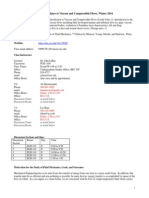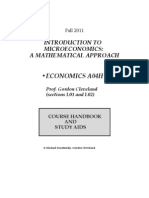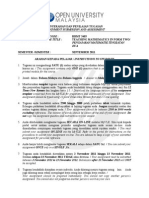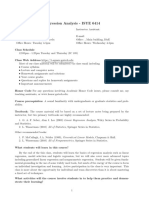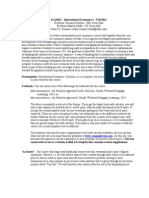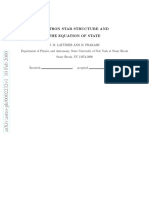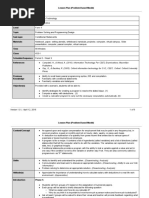Boc+Memo Syllabus
Boc+Memo Syllabus
Uploaded by
Jose CrawfordCopyright:
Available Formats
Boc+Memo Syllabus
Boc+Memo Syllabus
Uploaded by
Jose CrawfordOriginal Description:
Original Title
Copyright
Available Formats
Share this document
Did you find this document useful?
Is this content inappropriate?
Copyright:
Available Formats
Boc+Memo Syllabus
Boc+Memo Syllabus
Uploaded by
Jose CrawfordCopyright:
Available Formats
APMA 2120 BoC Memo/Syllabus
Fall 2014
INSTRUCTOR: Mike Mohajeri
Office Phone: 243-1113
E-mail: mm2pa@virginia.edu
Office: THN B212
Office hours: Mon & Wed, 12:30 14:00
Fri, 8:30 9:30
Graduate TA: Marshall Tabetah
Email: met4t@virginia.edu
See APMA Workshop Schedule for hours
Undergraduate Grader/TA: Ryan Leiphart
Email: rjl2zw@virginia.edu
Office hours: Tues, 15:30 - 17:00
MEC 347
APMA Workshop: Thornton A238
The APMA Workshop schedule is posted on the UVaCollab site APMA 2120 /
All under Resources.
TEXT: Calculus, 2nd edition by Jon Rogawski. We will cover Chapters 12-17.
COURSE DESCRIPTION
APMA 2120 is an applied math course aimed at developing necessary skills and knowledge
needed in many of the engineering courses that you will be taking. Multivariable calculus is a
natural extension from the single variable domain to that of multiple variables. We will discuss
some theory but the emphasis will be on solving problems, many with an engineering flavor.
More than just an endpoint, however, the advanced topics in this course provide a gateway to a
host of applications, not only in engineering and physics but also in biological, earth, and
environmental sciences, where an understanding of fluid and aerodynamics, and continuous
matter is required.
This course is rich with geometric interpretations and applications in both 2-D and 3-D. Vectors
and vector functions are often used to represent and analyze physical phenomena such as force
and fluid flow. The differentiation portion of the course is also very geometric with the
introduction of the concepts of gradient, divergence, and curl. Integration is over more general
sets than just intervals as it deals with integration over curves, surfaces, and solid objects. In
addition, the usefulness of the Fundamental Theorem of Calculus is extended in the use of
Greens Theorem, Stokes Theorem and the Divergence Theorem.
On UVa Collab you will find a set of lecture notes in pdf form on the APMA 2120 / All page,
under Resources. These notes contain a wealth of information and will provide the framework
for learning and understanding the key teaching/learning objectives in the course. You will be
expected to use these notes and augment/personalize them based on class discussions/exercises,
associated readings in the textbook, and what you learn through the assigned homework
exercises. Many of the lessons will lend themselves to graphic demonstrations that will enhance
your understanding of the geometry of the material and add to your appreciation of what we are
doing and the richness of its applications. Class periods will involve your active engagement in
exercises related to the lesson material. The exercises will typically require solving core
problems similar to those assigned for homework. At the conclusion of each class, you should
have a good appreciation of the breadth and depth of the lesson material and an assessment of
your confidence level for the material.
9/11/2014
APMA 2120 BoC Memo/Syllabus
Fall 2014
PRE-REQUISITES:
Trigonometry Basic trigonometric identities, graphs of trigonometric functions, and key
values of trigonometric functions.
Graphing All students should be able to graph linear and quadratic functions, factored
polynomials, the conic sections, and rational functions.
Algebra The quadratic formula, factoring, solving equations and inequalities.
Calculus All topics covered in Calculus I and II.
COURSE OBJECTIVES
Understand how vectors and vector functions can be used to represent and analyze
physical phenomena (e.g., force, fluid flow, energy, and motion)
Understand how core concepts learned in Calculus I and II can be extended to functions
involving multiple variables to solve varied engineering problems (e.g., solving
optimization problems in 3-D instead of 2-D).
Solve applied multivariable problems represented in 2-D and 3-D using vector operations
and relationships and/or multivariable differentiation and integration techniques (e.g.,
solving center of mass problems for 3-D objects).
Extend the concept of single vectors in space to that of vector fields to represent such
things as fluid flow.
Extend basic concepts involving integration over an interval to more general line
integrals to solve problems such as finding arc length, mass and fluid flow along a curve.
Extend basic concepts involving integration over a region to more general surface
integrals to solve problems such as finding areas of a surface, and analyzing fluid/energy
flow over/through a surface.
Relate the Fundamental Theorem of Calculus with respect to single variables to the
multivariable versions known as Greens, Stokes, and the Divergence Theorems.
Gain a better appreciation of how vector calculus can be used to solve advanced problems
in fields such as physics, engineering, and biological sciences.
Use the concepts and problem solving skills gained in this course in other applicable
engineering courses.
READINGS AND KEY DATES
See reading assignments and key dates in Course Calendar
Websites:
See APMA 2120- 1 & 5 page on Collab for your section-related material.
See APMA 2120 / ALL page on Collab for material common to all sections of
APMA 2120 (e.g., lecture notes).
9/11/2014
APMA 2120 BoC Memo/Syllabus
Fall 2014
Tips for Success:
Use the lecture notes that are provided to full advantage. They cover the breadth and depth
of what is expected in the course. If you understand what is represented in the notes, you
will have a good understanding of what is expected in the course. Toward this end, read the
text and augment the notes based on your readings and what is discussed in class. This will
help to personalize the notes and aid your understanding.
You will find a star symbol in the left margin of most of the pages of the lecture notes. This
symbol denotes a practice problem that will be worked and discussed in class or may be
assigned to be completed before the next class accordingly, blank space will follow the use
of this symbol to allow you room for your computations. These embedded problems convey
most of the kinds of problems that you will be expected to solve on homework, quizzes, and
tests.
A complete set of lecture notes (including solutions to the embedded practice problems) will
be provided at the end of each week. A hardcopy of this file will be an excellent tool when
you prepare for.
ASSESSMENT AND EVALUATION
The following table provides the weight of each form of assessment used in this class. Curving
grades, if necessary, will only be done after the final exam.
Homework:
Quizzes:
3 Mid-terms:
Final Exam:
10%
15%
45%
30%
The 10% of the total grade allocated to homework will be distributed as follows:
WeBWork Assignments:
Written Assignments:
Readiness Assessments:
5%
4%
1%
Weekly Homework:
Homework assignments provide a vehicle for practicing the skills and knowledge learned
in the course on problems that are representative of those that you will be expected to be
able to solve on quizzes, tests, and the final exam. These weekly assignments will consist
of two elements: (1) an online assignment administered via WeBWorK, usually due on
Wednesday, and (2) a written assignment, usually due on Thursday. With the WeBWork
assignments since your results will be entered online, you will get immediate feedback
for self-assessment purposes. For these online assignments, you are encouraged to work
the problems in a hardcopy form and then enter your answers electronically; the hardcopy
will be useful when you prepare for quizzes and tests. WeBWork assignment scores will
become part of your grade. Your written homework scores will be based on
9/11/2014
APMA 2120 BoC Memo/Syllabus
Fall 2014
neatness/readability, completeness, and correctness. These assignments scores will also
become part of your final grade.
In studying the material and doing homework, you are encouraged to collaborate with
other students to gain a better understanding of how to solve a problem; however, your
final submissions must be your own work!
Readiness Assessments:
These assessments will take the form of in-class questions related to mini-homework
exercises (e.g., completing the solution to an embedded problem). Since advance
preparation is vital to your success in the class, the results of these assessments will be
maintained throughout the semester and become part of your final grade.
Weekly Quizzes:
Written closed-book quizzes (15-20 minutes in length) will provide you with a test on
your ability to understand a weeks worth of material and solve meaningful related
problems. At the end of the semester your lowest-scored quiz will be dropped.
Mid-Term Tests:
Three 50-minute tests will be given during the semester to assess and evaluate your
performance over major blocks of material. All tests are cumulative. The problems will
range from mid-level difficulty similar to those presented in class and given on quizzes
to more challenging problems that require you to synthesize several concepts.
Final Exam:
A three-hour exam will be given at the end of the course over the entire set of material
covered in the course. This will be the final test to see how well you have been able to
learn the material and solve meaningful problems. The test will be comprehensive in
nature problems will be of the same basic level of difficulty as the mid-terms.
CONDUCTING CLASSES
My MWF classes will generally be conducted in two parts. The first 10 to 15 minutes of class
will typically be spent reviewing the preceding lesson and going over the imbedded problems in
that lesson. During this time, I will call on individual students to walk through their solutions to
imbedded problems and thereby assess their readiness. You will be expected to have studied the
preceding lesson and solved the imbedded problems included in the that lesson The last 35 to 40
minutes of class will be devoted to the current lesson. I will teach from the content of the lecture
notes posted on the APMA 2120 / All page; you are encouraged to take notes during the
discussions. Although you are not expected to study the lecture notes before class, you will find
a 5- to 10-minute perusal to be helpful in your learning process.
9/11/2014
APMA 2120 BoC Memo/Syllabus
Fall 2014
My Thursday (fourth hour) classes will also generally be conducted in two parts. The first 30
to 35 minutes of class will be spent reviewing the preceding lessons by walking through some
supplemental problems, which will generally be the same as or similar to the written
homework to be submitted at the beginning of the class. The last 15 to 20 minutes will be
allocated to the weekly quiz.
COURSE POLICIES
Tests and Final Exam These tests are scheduled in the Course Calendar section of this
Syllabus. Do not make travel plans that will conflict with the scheduled dates and times.
Make-up Tests Make-up quizzes are not given. Make-up tests and final exam are not
given except under exceptional circumstances, which your instructor must approve at
least 48 hours in advance. Anyone missing a test or the final without 48 hours notice and
your instructors approval should expect a grade of 0.
Calculators Calculators cannot be used on quizzes, tests, or the final examthey may
be used for homework.
Study Time The engineering school expects students to spend approximately 2 hours
outside of class studying for every hour in classAPMA 2120 is a four-hour course.
Attendance policy: Regular attendance is expected, and your record of attendance may be
used to determine borderline grade.
Classroom Etiquette: Please (1) arrive on time and (2) turn off your cell phone. You
may use your computer only to view the lecture notes. All other electronic devices must
be turned off and put away before class begins. If you use a cell phone, iPad, etc. during
class, I may ask you to leave the classroom!
LEARNING NEEDS:
If you have learning needs that have been evaluated by the Student Disability Access Center
(SDAC), I will be happy to accommodate them and help you accordingly. You must, however,
provide documentation from SDAC within the first two weeks of the semester or whenever you
are evaluated, preferably at least one week before an exam. The contact information for SDAC
is sdac@virginia.edu and 243-5180 (phone).
HONOR CODE:
The honor code will be strictly observed in my classes. Please remember to pledge each quiz,
each test and the Final Exam.
IMPORTANT DATES:
Please be aware of the following dates for engineering students. (Students enrolled in the college have
different deadlines.)
First day of classes:
Last day to add a course:
Family Weekend:
Reading Days (no class)
Last day to drop a course:
9/11/2014
Tuesday August 26th
Tuesday, September 9th, 4:30 pm
Friday, October 31st Sunday, November 2nd
Monday, October 13th & Tuesday, October 14th
Wednesday, October 15th, 4:30 pm
5
APMA 2120 BoC Memo/Syllabus
Fall 2014
Last day to withdraw from a course:
Thanksgiving Recess (no class):
Last day of classes:
Reading Day:
Final Exams Begin:
APMA 2120 Final Exam:
Reading Days:
Final Exams End:
9/11/2014
Tuesday, October 21st, 4:30 pm
Wednesday, November 26th Friday, November 28th
Friday, December 5th
Sunday, December 7th
Monday, December 8th
Monday, December 8th, 7:00 10:00 pm
Thursday, December 11th & Sunday, December 14th
Tuesday, December 16th
APMA 2120 BoC Memo/Syllabus
Fall 2014
COURSE CALENDAR (Fall 2014)
Week
1
Dates
Aug 26-29
Sept 1-5
HW#1/Q
Sept 8-12
HW#2/Q
Sept 15-19
HW#3/Q
5
Test 1 Fri, Sept 26
In Class
Sept 22-26
HW#4
Sept 29-Oct 3
HW#5/Q
Oct 6-10
HW#6/Q
8
READING DAYS
Oct 13 - 14
9
Test 2 Fri, Oct 24
In Class
Oct 13-17
HW#7/Q
10
Oct 27-31
HW#9/Q
11
Nov 3-7
HW#10/Q
12
Nov 10-14
HW#11/Q
13
Test 3 Fri, Nov 21
In Class
Nov17-21
HW#12
9/11/2014
Oct 20-24
HW#8
Readings/ Topics
Course Overview on First Day
Chapter 12 Vector Geometry
12.1 Vectors in the Plane
12.2 Vectors in Three Dimensions
12.3 Dot Product and Angle between Two Vectors
12.4 The Cross Product
12.5 Planes in Three-Space
12.6 A survey of Quadric Surfaces
12.7 Cylindrical and Spherical Coordinates
Chapter 13 Calculus of Vector Valued Functions
13.1 Vector-Valued Functions
13.2 Calculus of Vector-Valued Functions
13.3 Arc Length and Speed
13.4 Curvature
13.5 Motion in Three-Space
Chapter 14 Differentiation in Several Variables
14.1 Functions of Two or More Variables
14.2 Limits and Continuity in Several Variables
Test 1: Sections 12.1 13.5
14.3 Partial Derivatives
14.4 Differentiability and Tangent Planes
14.5 The Gradient and Directional Derivative
14.6 The Chain Rule
14.7 /Day 1 Optimization in Several Variables
14.7 / Day 2 Optimization in Several Variables
14.8 Optimization using Lagrange Multipliers
Chapter 15 Multiple Integration
15.1 Integration in two Variables
15.2 Double Integrals over General Areas
15.3 Triple Integrals
Test 2 Review
Test 2 Chapter 14
15.4 Integration in Polar, Cylindrical, and Spherical Coordinates
15.5 Applications of Multiple Integrals
15.6 Change of Variables
Chapter 16 Line and Surface Integrals
16.1 Vector Fields
16.2 / Day1 Line Integrals
16.2 / Day 2 Line Integrals
16.3 / Day 1 Conservative Vector Fields
16.3 / Day 2 Conservative Vector Fields
16.4 Parametrized Surfaces and Surface Integrals
16.5 Surface Integrals of Vector Fields
Chapter 17 Fundamental Theorems of Vector Analysis
17.1 Greens Theorem
Test 3 Review
Test 3 Chapters 15 and 16
7
APMA 2120 BoC Memo/Syllabus
Fall 2014
14
THANKSGIVING
Nov 26
15
Nov 24-28
17.2 /Day 1 Stokes Theorem
Dec 1-5
HW#13/Q
17.2 /Day 2 Stokes Theorem
17.3 Divergence Theorem
Final Exam Review
Final Exam, Monday, December 8, 7 10 PM
9/11/2014
You might also like
- Syllabus For CPSC 121 201 - 202 - 203 - 204 2020W Models of ComputationDocument9 pagesSyllabus For CPSC 121 201 - 202 - 203 - 204 2020W Models of ComputationJIANG YUHUANNo ratings yet
- Assessment Task 1 Standard Yr 11 2024Document14 pagesAssessment Task 1 Standard Yr 11 2024muhammadkhan8680No ratings yet
- IELTS Academic Writing: Important Tips & High Scoring Sample AnswersFrom EverandIELTS Academic Writing: Important Tips & High Scoring Sample AnswersRating: 4 out of 5 stars4/5 (25)
- Valedictorian Speech For Graduating Elementary StudentDocument1 pageValedictorian Speech For Graduating Elementary Studentangelouve100% (10)
- Fatema - 2167025Document7 pagesFatema - 2167025Mehedi HasanNo ratings yet
- PDE Syllabus S10Document2 pagesPDE Syllabus S10lenin_edaNo ratings yet
- Apma 3100 Practice Exam 1Document7 pagesApma 3100 Practice Exam 1Jose CrawfordNo ratings yet
- Boc+Memo SyllabusDocument8 pagesBoc+Memo SyllabusJose CrawfordNo ratings yet
- General Chemistry Laboratory Manual CHEM 1611/1621: University of VirginiaDocument75 pagesGeneral Chemistry Laboratory Manual CHEM 1611/1621: University of VirginiaJose CrawfordNo ratings yet
- MGT 6110 ExamDocument13 pagesMGT 6110 Examabdirahman100% (1)
- E V C C: Astern Isayas Entral OllegesDocument4 pagesE V C C: Astern Isayas Entral OllegesAllan IgbuhayNo ratings yet
- MAE130B: Intro To Viscous and Compressible Flows, Winter 2014Document8 pagesMAE130B: Intro To Viscous and Compressible Flows, Winter 2014Winslow ThaiNo ratings yet
- EAS 207 - ABET - Spring - 20130123Document6 pagesEAS 207 - ABET - Spring - 20130123SyedZain1993No ratings yet
- Teaching Eng. Through Lit. CW 1Document12 pagesTeaching Eng. Through Lit. CW 1AmeeraNo ratings yet
- LINEARMODELS Student ManualDocument4 pagesLINEARMODELS Student Manualnganko germainNo ratings yet
- Syllabus PHY 4140 2023 SpringDocument6 pagesSyllabus PHY 4140 2023 SpringMonique Del toroNo ratings yet
- ECO4000 SyllabusDocument10 pagesECO4000 SyllabusshakeraojNo ratings yet
- ENGR240 Applied Numerical MethodsDocument6 pagesENGR240 Applied Numerical MethodsAldo M. BarlettaNo ratings yet
- Om 368: Logistics and Inventory Management Spring 2013 Unique No. 04240: MW 11:00 - 12:30 AM in UTC 1.146Document7 pagesOm 368: Logistics and Inventory Management Spring 2013 Unique No. 04240: MW 11:00 - 12:30 AM in UTC 1.146berkNo ratings yet
- Introto Micro HANDBOOKECMA04Document36 pagesIntroto Micro HANDBOOKECMA04Sama MaqsoodNo ratings yet
- InfoDocument15 pagesInfoSdsu HbsaNo ratings yet
- Part I Solutions AllDocument167 pagesPart I Solutions Allalbusfons939393No ratings yet
- Form 2 MathDocument5 pagesForm 2 MathkhairliaNo ratings yet
- CE 321 Syllabus - Fall 2017Document5 pagesCE 321 Syllabus - Fall 2017Rashid AliNo ratings yet
- Regression Analysis - ISYE 6414Document3 pagesRegression Analysis - ISYE 6414Yasin Çagatay GültekinNo ratings yet
- Faculty of Science School of Mathematics and Statistics: MATH3121 Mathematical Methods & Partial Differential EquationsDocument8 pagesFaculty of Science School of Mathematics and Statistics: MATH3121 Mathematical Methods & Partial Differential EquationsGreeshma RcNo ratings yet
- PGDEVS July 23-July 2024Document16 pagesPGDEVS July 23-July 2024Kshitiz RawatNo ratings yet
- COMP 248 Outline Fall 2016Document4 pagesCOMP 248 Outline Fall 2016Michael TangNo ratings yet
- Engineering Dynamics PHY/EGR 321.001 Syllabus - Spring 2015Document5 pagesEngineering Dynamics PHY/EGR 321.001 Syllabus - Spring 2015Alvaro MejiaNo ratings yet
- 24-221 Thermo-I Syllabus Singh 08252014Document7 pages24-221 Thermo-I Syllabus Singh 08252014TaoTao at NYCNo ratings yet
- EML 4501 SyllabusDocument4 pagesEML 4501 SyllabusShyam Ramanath ThillainathanNo ratings yet
- Syllabus CEE220Document5 pagesSyllabus CEE220appstore500No ratings yet
- Course Objectives: Calculus 1 SyllabusDocument8 pagesCourse Objectives: Calculus 1 SyllabusEithar FadlNo ratings yet
- Course Packet: 95-710 A1/C1 - ECONOMIC ANALYSIS (Remote Course)Document13 pagesCourse Packet: 95-710 A1/C1 - ECONOMIC ANALYSIS (Remote Course)ro paNo ratings yet
- Me 200 - Thermodynamics I COURSE POLICY - Spring 2017Document5 pagesMe 200 - Thermodynamics I COURSE POLICY - Spring 2017Potatoes123No ratings yet
- Cps211 - Object-Oriented Software DevelopmentDocument7 pagesCps211 - Object-Oriented Software Developmentbano tamimNo ratings yet
- Cive 260 Statics Syllabus: Course DescriptionDocument12 pagesCive 260 Statics Syllabus: Course DescriptionSisay TesfayeNo ratings yet
- Assignment Booklet Mscenv Mscenv I Mev 011 Mev012 Mev 013Document9 pagesAssignment Booklet Mscenv Mscenv I Mev 011 Mev012 Mev 013Adnan Rasheed ParimooNo ratings yet
- Stats 2150Document7 pagesStats 2150Nwogo DanielNo ratings yet
- Syllabus 3221 Spring 2022Document9 pagesSyllabus 3221 Spring 2022guerreirosubzeroNo ratings yet
- AirpolutionDocument4 pagesAirpolutionDien NoelNo ratings yet
- ChEn 2001 Fall 2013 SyllabusDocument5 pagesChEn 2001 Fall 2013 Syllabustripa034No ratings yet
- c346 w15 Course OutlineDocument4 pagesc346 w15 Course OutlineAmine BadraouiNo ratings yet
- Principles of Engineering Economic AnalysisDocument40 pagesPrinciples of Engineering Economic AnalysisSalih A. Razag Jr.50% (4)
- MA211 F2F O Course Outline 202201 JaiDocument11 pagesMA211 F2F O Course Outline 202201 JaiKavineel KumarNo ratings yet
- 1301 Fall 2021Document7 pages1301 Fall 2021Jacky RodriguezNo ratings yet
- CVEN2002 2702 Course Profile v15Document9 pagesCVEN2002 2702 Course Profile v15Seanam DMNo ratings yet
- MATH3570 Foundations of Calculus: Faculty of Science School of Mathematics and StatisticsDocument8 pagesMATH3570 Foundations of Calculus: Faculty of Science School of Mathematics and StatisticsHuai Kai LinNo ratings yet
- CVEN1300 Course Profile S2-2014Document6 pagesCVEN1300 Course Profile S2-2014Alan TruongNo ratings yet
- 2040 Summer 2015 Syllabus+Weitnauer+updated+05-11-2015Document6 pages2040 Summer 2015 Syllabus+Weitnauer+updated+05-11-2015theaznnoobieNo ratings yet
- Assignment Booklet Mscenv I Semester Jan 2022Document9 pagesAssignment Booklet Mscenv I Semester Jan 2022Krishna SharmaNo ratings yet
- Syllabus f22Document5 pagesSyllabus f22Samya SNo ratings yet
- Econ1540 N Outline (Rev)Document5 pagesEcon1540 N Outline (Rev)jiyer80767No ratings yet
- Mscenv Jan Jul 2021Document9 pagesMscenv Jan Jul 2021Si KriNo ratings yet
- Syllabus 201102 L31 198 01Document6 pagesSyllabus 201102 L31 198 01swagonswagonswagNo ratings yet
- ECE 201 Introduction To Signals and Systems: CRN #80681 Fall 2017 SyllabusDocument5 pagesECE 201 Introduction To Signals and Systems: CRN #80681 Fall 2017 SyllabusAaron SmithNo ratings yet
- CHE456 Syllabus Fall2013Document6 pagesCHE456 Syllabus Fall2013Jusang BotangNo ratings yet
- Thomas Nechyba OriginalDocument5 pagesThomas Nechyba OriginalYuki ZhangNo ratings yet
- CM1009 - Course Guide 2011-2012Document14 pagesCM1009 - Course Guide 2011-2012Elyse van ZandvoortNo ratings yet
- Syllabus Ec240a Fall2024Document7 pagesSyllabus Ec240a Fall2024Ethan LiNo ratings yet
- 526 Syllabus PDFDocument5 pages526 Syllabus PDFGaurav JakhuNo ratings yet
- Economics 526 - Mathematics For Economists: Day(s) Time LocationDocument5 pagesEconomics 526 - Mathematics For Economists: Day(s) Time LocationGaurav JakhuNo ratings yet
- Study GuideDocument16 pagesStudy GuidetototapzNo ratings yet
- Cos 116 Jun09Document16 pagesCos 116 Jun09Nayab Rasul ShaikNo ratings yet
- Syll12 PDFDocument1 pageSyll12 PDFsuhail khanNo ratings yet
- W24 MGAB02 Course OutlineDocument12 pagesW24 MGAB02 Course Outlineselahanna2005No ratings yet
- Lattimer Prakash NS-EOSDocument51 pagesLattimer Prakash NS-EOSJose CrawfordNo ratings yet
- HW1 PDFDocument6 pagesHW1 PDFJose CrawfordNo ratings yet
- Discrete Math Homework 1Document4 pagesDiscrete Math Homework 1Jose CrawfordNo ratings yet
- Before We Start. - .: Please Make Two Entries in Your Idea NotebookDocument22 pagesBefore We Start. - .: Please Make Two Entries in Your Idea NotebookJose CrawfordNo ratings yet
- Waveform From Problem 5, Plotted With V 1, From T 0 To 1/500 (To The 100 Harmonic)Document1 pageWaveform From Problem 5, Plotted With V 1, From T 0 To 1/500 (To The 100 Harmonic)Jose CrawfordNo ratings yet
- AMTStudentNotes PDFDocument447 pagesAMTStudentNotes PDFJose CrawfordNo ratings yet
- Chaitanya Saaboo Pandula: EducationDocument2 pagesChaitanya Saaboo Pandula: EducationPHANEENDRA SAINo ratings yet
- Guidelines For RC Tones PDFDocument4 pagesGuidelines For RC Tones PDFArun SharmaNo ratings yet
- MC5 CoCU 1 - Welding Joint ApplicationDocument5 pagesMC5 CoCU 1 - Welding Joint Applicationnizam1372No ratings yet
- Sample Test DocumentsDocument158 pagesSample Test DocumentsSarmad farhan khanNo ratings yet
- What is Gratitude G5 SuggestionDocument3 pagesWhat is Gratitude G5 SuggestionreemaNo ratings yet
- Authentication DocsDocument2 pagesAuthentication DocsAditya PrakashNo ratings yet
- Faria International School Term One Report: Student Name: Class: Tutor: PreparedDocument6 pagesFaria International School Term One Report: Student Name: Class: Tutor: Preparedtheodore2106No ratings yet
- Ve270 Introduction To Logic Design: Summer 2015Document4 pagesVe270 Introduction To Logic Design: Summer 2015Arnold ZhouNo ratings yet
- Advanced Theories of Personality - Theories of Personality - Without AnswersDocument22 pagesAdvanced Theories of Personality - Theories of Personality - Without AnswersRD Patricio100% (1)
- Action Resarch PupDocument57 pagesAction Resarch PupJohn Rhey Lee Gonzaga (GONZAGA, JOHN RHEY L.)No ratings yet
- 3 METHODS-AND-STR-WPS-OfficeDocument7 pages3 METHODS-AND-STR-WPS-Officemarianbuenaventura03No ratings yet
- Suggested Classroom AccommodationsDocument3 pagesSuggested Classroom Accommodationsmasawanga kisulilaNo ratings yet
- Ped 3150 Professional Learning RecordDocument17 pagesPed 3150 Professional Learning Recordapi-529764234No ratings yet
- AdaBoost New PDFDocument45 pagesAdaBoost New PDFRaphaelNo ratings yet
- Intensive English 1: Unit 1: Getting To Know YouDocument6 pagesIntensive English 1: Unit 1: Getting To Know YouthulesiucuteNo ratings yet
- 2016-2017 Classroom Walkthrough Form - Google FormsDocument18 pages2016-2017 Classroom Walkthrough Form - Google Formsapi-252558036No ratings yet
- DETAILED LESSON PLAN 4th QuarterDocument9 pagesDETAILED LESSON PLAN 4th Quarterdusha leigh toleteNo ratings yet
- Lesson Plan (Problem Based Model) : Publishers. PressDocument9 pagesLesson Plan (Problem Based Model) : Publishers. PressOlaNo ratings yet
- General: What Are The Reactions of My Family/parents On My Preparation?Document4 pagesGeneral: What Are The Reactions of My Family/parents On My Preparation?Yenyen Quirog-PalmesNo ratings yet
- Our Country, Cities & SchoolDocument33 pagesOur Country, Cities & SchoolToader DianaNo ratings yet
- Sir MVDocument4 pagesSir MVrvkumar3619690No ratings yet
- Application Form State Level National Talent Search Examination - 2012 (For The Students Studying in Class - VIII)Document4 pagesApplication Form State Level National Talent Search Examination - 2012 (For The Students Studying in Class - VIII)Sridhar BulusuNo ratings yet
- Norway FinalDocument82 pagesNorway FinalRitzuchan001No ratings yet
- Abc - Recording - Form 3Document3 pagesAbc - Recording - Form 3Sudhakar PrasannaNo ratings yet
- Dr. P.S. Dara: Kendriya Vidyalaya SangathanDocument2 pagesDr. P.S. Dara: Kendriya Vidyalaya SangathanAnonymous QAZHskNo ratings yet
- A Textbook Case of Nation-BuildingDocument53 pagesA Textbook Case of Nation-BuildingfrostarchivistNo ratings yet











